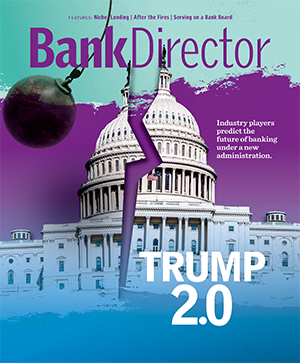Alan J. Kaplan is the Founder and CEO of Kaplan Partners, a 31-year-old Philadelphia-based retained executive search and board advisory firm. You can reach Alan at 610-642-5644 or [email protected].

Five Keys to Successful Leadership in 2025
Bank executives should embrace these effective management traits to better navigate challenges in the coming year.
Brought to you by Kaplan Partners

Each new year brings an opportunity to reset, refresh and reengage. As industry leaders, it’s a fitting time to contemplate what lies ahead and how to navigate the inevitable uncertainties.
Here are five key elements of executive leadership to keep in mind and continue refining in the year ahead.
1. Strategic Thinking
Banks, by nature, are plan oriented. Since the earliest days of modern economics, banks have worked to protect their business and safeguard their customers. However, the pace of change has never been more rapid, and effective bank leaders benefit from the ability to peer around the corner and see what lies ahead. Crafting strategies for growth while safeguarding the institution can sometimes be a tricky balancing act. A failure to plan and construct alternatives based on ever-changing conditions is not a recipe for success. Successful bank leaders always keep one eye on the windshield and not just on the regulatory-driven rearview mirror.
2. Agility
Much has been written recently about the need for bank leaders to be agile. This differs from being strategic and a planner. A strategic mindset provides a framework for how and where the bank is heading or which direction to go when circumstances change. Agility is the ability to implement changes in plans or strategic direction effectively. Developing a mindset that fosters adaptability for yourself and your executive team is a hallmark of successful modern leaders.
3. Authenticity
You can almost always recognize an authentic leader when you meet one. These are the executives who mean what they say and do as they promise, rather than saying one thing and acting differently. Authentic leaders typically possess a high level of emotional intelligence — the ability to be significantly self-aware and moderate themselves situationally as needed. Authentic leaders can create a higher degree of followership, which directly relates to their ability to be agile in pursuing good plan execution.
4. Communication
I’ve always believed that one cannot overcommunicate, whether in personal dealings or business life. Too often, leaders fail to be open and transparent about what is happening within the institution or where the bank is heading. The lack of well-crafted internal and external communication plans makes it harder for employees to align with the strategy and changes ahead. It is challenging to create trust when people do not know where the company is going and how they fit in.
5. Talent Matters
This is my favorite expression, of course. None of the above can truly be enhanced without a strong group of executive leaders, overseen by a highly capable CEO. The highest-performing banks we observe typically have a culture that employees can feel, led by individuals who embody the bank’s values and engender followership. A CEO who prioritizes attracting, retaining and developing superior talent is best positioned to grapple with inevitable changes in strategy and evolving external and market factors. The need to pivot will arise yet again. The successful leader must fully embrace the need for authentic and highly communicative leadership for the institution to thrive and grow.
Anything less may put the future of the bank at risk.


